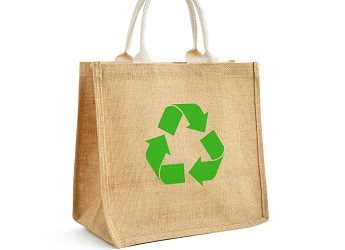
Paper or plastic? Or, neither? Decisions about which shopping bags to use or which canteen to buy make a difference—make the eco-friendly choice.
Find the Right Reusable Bottle
Plastic. Aluminum. Steel. There are plenty of reusable bottles out there, but which choice is right for you?
Reusable plastic bottles are typically an easy-to-clean inexpensive option that comes in an assortment of colors and sizes. Make sure the bottle does not contain hazardous plastics, such as numbers three and six (3). These plastics release toxic chemicals into the substance they hold, which can be damaging to your overall health (3). Look for BPA-free options.
Aluminum bottles are a lightweight option, but aluminum is reactive with acidic liquids; aluminum bottles must be lined with special materials that help ensure no metallic taste or bacteria build up. Look for bottles lined with BPA-, phthalate- and VOC-free materials (3).
Vacuum insulation is a great feature in many stainless steel bottles. This produces an absence of matter between two stainless steel walls so the temperature outside the flask won’t affect the temperature inside of the flask (1). Studies show that with vacuum insulation, hot beverages remain hot for up to six hours, while cold beverages remain cold for up to 24 hours (1).
Also, look for bottles with curved corners, which prevents harmful bacteria from building up and seeping into the corners of the bottle (2).
The Peril of Plastics
Do you know where your plastics go?
In 2008, an estimated 2,480,000 tons of plastic bottles and jars were thrown away (4). According to a 2006 study, an estimated 60 billion PET plastic bottles were bought, with 45 billion of those discarded immediately after use (4). In that same year, bottled water spending was estimated at $100 billion in the United States (4).
Plastics do not biodegrade, but rather photodegrade; this is when materials break down into smaller fragments (4). These fragments contaminate soils, waterways and infiltrate animals’ digestion systems (4). In the Great Pacific Garbage Patch, which expands from the U.S. West Coast to Japan, plastics make up the majority of the marine debris (6).
Each time a consumer uses one plastic bag at a grocery store, it will take anywhere from 15 to 1,000 years to decompose (5). In the United States, only 1% of plastic bags are recycled (5). Alternatives to plastic bags are far less detrimental to the environment and ecosystem.
Reusable Bags Need-to-Know
Cotton and canvas reusable bags are constructed of traditional, organic or recycled cotton (7). Organic cotton is farmed and produced from non-genetically modified plants without pesticides. These material bags are soft, contain biodegradable natural fibers and are machine washable (7).
Hemp is a more expensive, yet a stronger material than cotton. The hemp plant can grow in poor soil conditions and is drought tolerant, therefore no pesticides or fertilizers are needed to sustain this plant (7). Hemp is typically combined with cotton materials and is machine wash friendly (7). A cotton fiber that is not bleached or fully processed, calico, is a less expensive reusable bag. Similar to cotton, reusable calico bags are durable and long lasting (7).
Strong and chemical-resistant polypropylene bags may be constructed from recycled materials and come in a wide variety or patterns and colors (8). This material cannot be machine washed, but can be wiped or sprayed with cleaning utensils. Polypropylene is a non-renewable resource as well as a type of plastic; consequently it is non-biodegradable (8).
Reusable paper bags, though recyclable and biodegradable, are not resilient; especially when wet, these bags tear and lose strength easily (7). Since paper is heavier than plastic, transportation, distribution and storage costs are higher for paper bags than plastic bags.
Cleaning your reusable bags is extremely important and should be done frequently. Washing your bags prevents yeasts and bacteria from growing, while also preventing cross contamination with food.
First, experts say to clean after every other time the bag is used. Second, use separate shopping bags for seafood, meat and produce and label them as such. Also, keep food and non-food items separate. Third, store food items in bags only when they are dry. Store your bags in a cool and dry environment where air can circulate to avoid bacteria growth (9). For specific instructions on how to clean, follow the labels on your reusable bags. WF
References
1. Hydroflask, www.hydroflask.com, accessed July 24, 2015.
2. Klean Kanteen, kleankanteen.com, accessed July 24, 2015.
3. Ban the Bottle, Banthebottle.net, accessed July 24, 2015.
4. ReUseIt, Reuseit.com, accessed July 24, 2015.
5. J. Erdos, “Why You Should Use A Reusable Grocery Bag,” www.huffingtonpost.com/2012/04/06/reusable-grocery-bags_n_1409065.html, accessed July 24, 2015.
6. National Geographic, http://blog.education.nationalgeographic.com/2009/03/09/the_great_pacific_garbage_patch/, accessed July 24, 2015.
7. All About Bags, Allaboutbags.ca, accessed July 24, 2015.
8. www.bulletinbag.com/blog/faqs/reusable-bag-materials-comparison-guide, accessed July 24, 2015.
9. American Cleaning Institute, www.cleaninginstitute.org/clean_living/cleaning_reusable_bags.aspx , accessed July 24, 2015.
Published in WholeFoods Magazine, September 2015









